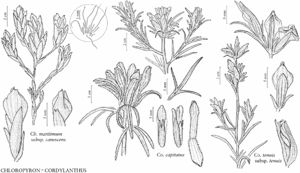Cordylanthus capitatus
in A. P. de Candolle and A. L. P. P. de Candolle, Prodr. 10: 597. 1846.
Stems erect or ascending, 10–50 cm, densely glandular-pubescent and pilose. Leaves glandular-pubescent and pilose; proximal 20–40(–50) mm, margins 3-lobed, lobes 1–2 mm wide; distal 10–30 × 1 mm, margins entire. Inflorescences capitate spikes, 2–5-flowered; bracts 1–5, 10–20 mm, margins 3-lobed, lobes green and purple, linear to linear-lanceolate. Pedicels: bracteoles 12–18 mm, margins entire. Flowers: calyx 10–15 mm, tube 2–4 mm, apex 2-fid, cleft 3–5 mm; corolla purple-red, apex yellow, 10–20 mm, throat 4–6 mm diam., abaxial lip 3–5 mm, ca. equal to and appressed to adaxial; stamens 2, filaments glabrous, fertile pollen sacs 1 per filament, vestigial pollen sacs present. Capsules ovoid to oblong-ovoid, 5–7 mm. Seeds 4–6, dark brown, narrowly ovoid to reniform, 2–2.5 mm, reticulate. 2n = 26.
Phenology: Flowering Jul–Oct.
Habitat: Openings in conifer woodlands and juniper scrub.
Elevation: 1400–2300 m.
Distribution
Calif., Idaho, Nev., Oreg., Wash.
Discussion
Cordylanthus capitatus is often associated with Artemisia tridentata and may be hemiparasitic on it.
Cordylanthus capitatus is distinguished by having only two anthers, each with one fertile pollen sac; infertile vestiges of the second pollen sac usually are present. The species can be recognized by its short-capitate inflorescences, the single, spathelike, deeply cleft calyx lobe, and the purple-red corollas with yellow tips.
Selected References
None.
